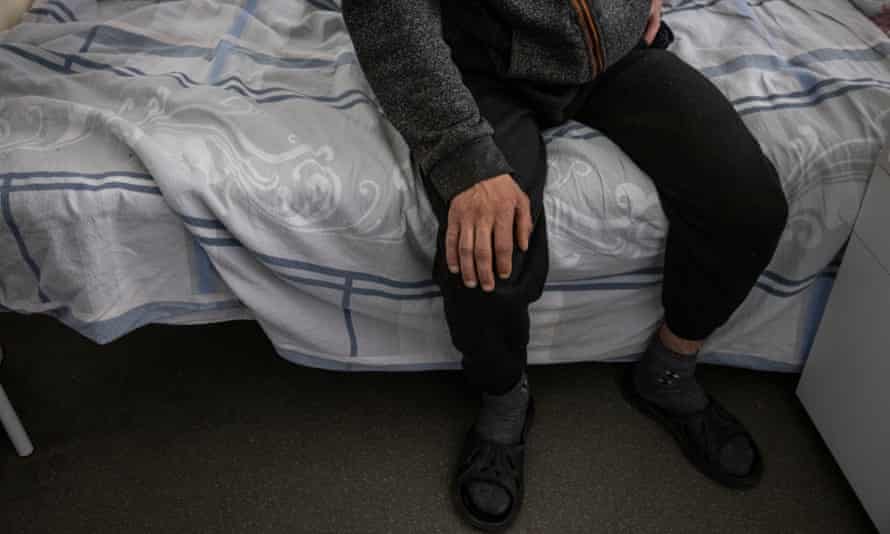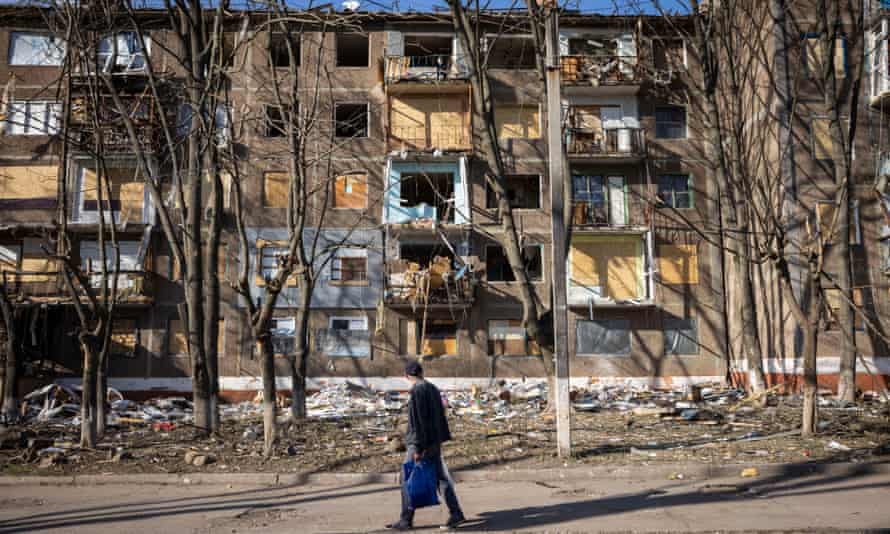Trial by fire: Ukraine war becomes gruelling artillery duel | Ukraine
The call came at about midday on Wednesday. There had been “chemical poisoning” after a blast and patients needed collecting.
Fears of a Russian chemical weapons attack have haunted Ukraine almost since the war began, and as the volunteer medics in Sloviansk pulled on the ageing gas masks and plastic overalls that were their only protection, they wondered if this was it.
They set off anyway, inured to personal risks after weeks of driving through shelling to patch up the men and women injured on one of the most intensely fought-over sections of the frontline.
“We got a call saying there was a yellow-brown cloud after the hit and yellow-white flakes in the air like snow. The soldiers immediately started having breathing problems,” said Vit, a paramedic who asked to go only by his nickname, which refers to his peacetime role as mayor of a small town. He was worried about being captured and tortured by Russian troops who were just a few miles away.
The ambulance team listened to the warning and then went to get the choking soldiers. Like the troops they support, they are supplementing limited, outdated equipment with courage and determination.

After dropping off their patient, who had gone into spasms in the ambulance, they were told the gas came not from chemical weapons but from a chemical plant that had been hit by Russian munitions.
But if the fear of one particular horror was put on hold for a moment, the other terrors of this war are drawing closer to this city in Donbas, less than 20 miles behind the frontline.
“You can win one battle then the next day there are more troops, sent back to the same place,” said Vlad, a veteran who signed up to fight again after the February invasion, and now a patient in a Sloviansk clinic. He asked not to give his last name because his family were in areas occupied by Russian troops and he feared they could face reprisals. His cheek shook when he talked about his children, and his fight was personal as well as patriotic.
This corner of the Luhansk and Donetsk regions is one of the few areas where Moscow’s army is still consistently gaining ground, even if their advance proceeds at a snail’s pace and recent attempts to bridge a strategically important river ended in a rout.
Ukraine has followed its victory in Kyiv by pushing Russian artillery back from within firing range of the country’s second largest city, Kharkiv. A senior general said this week that Moscow’s troops had been put on the defensive on several other key fronts, including along the Black Sea coast, and ministers have started talking about an offensive to take back territory lost in 2014.
But on the rolling steppe here, geography denies the Ukrainian military some of the advantages that allowed its forces to humble Moscow’s troops around the capital. Soldiers rarely get close enough to fight face to face or deploy the western anti-tank missiles that helped them save Kyiv. Instead, their artillery guns face off across vast open fields, dug in with mazes of trenches that could have come from the last century, pounding each other with shells while jets occasionally scream overhead.
Many Russian guns shoot further than the ones Ukraine’s military had at the start of the war, so while they wait for western weapons with a longer range – such as the M777 howitzers dispatched by the US and just starting to arrive at the frontline – they must live under constant bombardment.

“Positions where the Ukrainian army are staying are bombed with artillery, missiles and by air constantly, every day, so it gets to the point where there is nothing to hold on to in these points, that is part of the problem,” said Serhiy Haidai, the head of the military administration for the Luhansk region.
“The attacks with tanks we fight off, but we have no possibility to counter the artillery. That’s why unfortunately we have to retreat. We have been holding for three months already, and Russians couldn’t get through this small area. I hope the Ukrainian army will still hold these positions and – with the weapons we are waiting for – can even go into counterattack.”
After the humiliation of defeat near Kyiv, Vladimir Putin doubled down instead on the battle for the eastern Donbas region, where proxy forces have held ground seized in 2014 for eight years, claiming “independence” from Kyiv that provided a pretext for the wider invasion.
The ruthless bombardment they unleashed in pursuit of this goal shows in the type and scale of the injuries treated at the Sloviansk clinic, said Svitlana Druzenko, a paediatric trauma specialist and director of the all-volunteer Priogov mobile hospital, which treated the chemical poisoning victims.
She spent the first month of the war evacuating injured people from near frontlines in the capital. “In Kyiv and…
Read More: Trial by fire: Ukraine war becomes gruelling artillery duel | Ukraine

